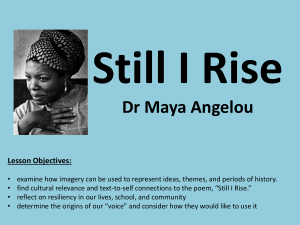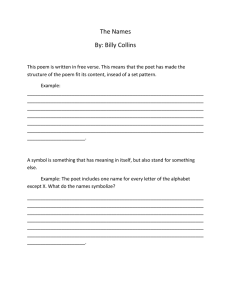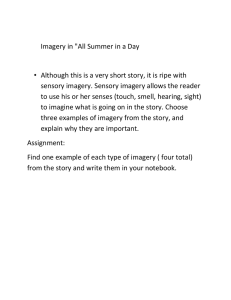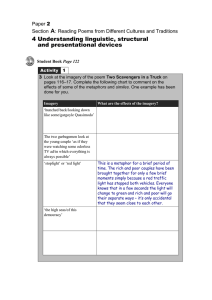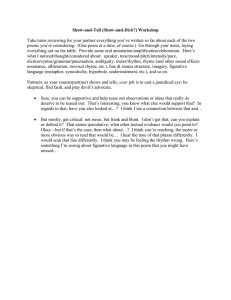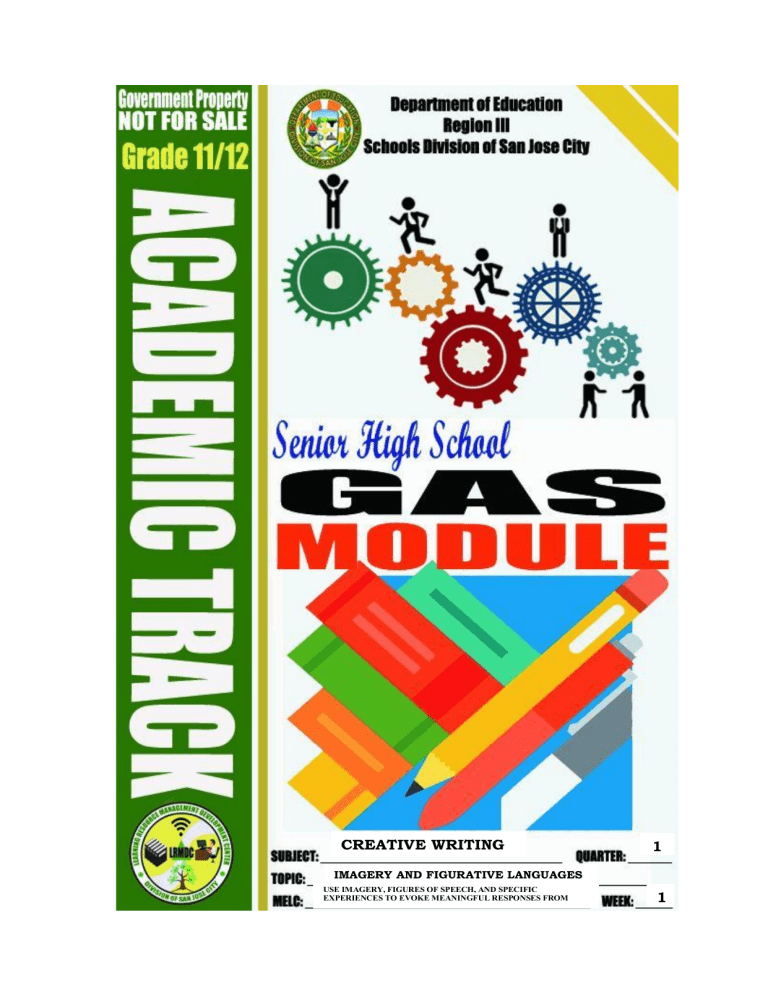
CREATIVE WRITING 1 IMAGERY AND FIGURATIVE LANGUAGES USE IMAGERY, FIGURES OF SPEECH, AND SPECIFIC EXPERIENCES TO EVOKE MEANINGFUL RESPONSES FROM READERS 1 12 SAMPLE Creative Writing Quarter 1 – Module 1 Imaging and the Use of Imagery Department of Education • Republic of the Philippines Creative Writing- Grade 12 Alternative Delivery Mode Quarter 1 – Module 1: Imaging and the Use of Imagery First Edition, 2020 Republic Act 8293, section 176 states that: No copyright shall subsist in any work of the Government of the Philippines. However, prior approval of the government office or office wherein the work is created shall be necessary for the exploitation of such work for a profit. Such agency or office may, among other things, impose as a condition the payment of royalties. Borrowed materials (i.e., songs, stories, poems, pictures, photos, brand names, trademarks, etc.) included in this book are owned by their respective copyright holders. Every effort has been exerted to locate and seek permission to use these materials from the respective copyright owners. The publisher and authors do not represent nor claim ownership over them. Published by School and Division Schools Division Superintendent: JOHANNA N. GERVACIO, PhD CESE Assistant Schools Division Superintendent: RAUL M. MARIN Curriculum Implementation Division Chief: VERONICA B. PARAGUISON, PhD Supervisor in-Charge in Senior High School: LORDENNIS T. LEONARDO, PhD Supervisor In-Charge: MARCOS C. VIZON Principal: NENITA D. MARTIN Development Team of the Module Author’s: MARY GRACE C. TAGLE Editor: BABY LIZA L. CIENCIA Reviewer: MARY GRACE P. VALENTON Illustrator: EVERLY P. CABRILLAS Layout Artist: Name Management Team: Name Printed in San Jose City by San Jose City National High School – Senior High School San Jose City Division- Curriculum Implementation Division, School Office Address: Sto. Niño 1st, Lupao-San Jose Road, San Jose City, Nueva Ecija 3121 Telefax: (044) 940 9740 E-mail Address: sanjosecity@deped.gov.ph 12 Creative Writing Quarter 1 – Module 1 Imaging and the Use of Imagery Department of Education • Republic of the Philippines Introductory Message Welcome to the world of Creative Writing for Grade 12 Alternative Delivery Mode (ADM) Module on understanding imagery, diction, figures of speech, and variations on language. This module which was collaboratively designed by the Schools Division of San Jose City will help guide both the facilitator in teaching the essential lessons in this subject and the learner to enhance their skills in writing. For the Facilitator: As a facilitator, you are expected to properly guide the learner in answering the different activities and tests in this module. The learner will find it easier and fun to learn in writing on his/her own if they will be acquainted with the lessons and the skills that need to be enhanced. This module is user-friendly and will fit the needs of the learner when it comes to writing creatively. Do not forget to always remind the learner to take good care of this module and to use separate sheets in answering the pre-test, self-check exercises, and post-test. For the Learner: This module is crafted and designed for you that contains proper language and content which will be easily understood by senior high school learners like you. This contains a lesson that will enhance your skills in writing as well as will challenge your creativity especially in thinking critically in applying imagery and figures of speech. Before you will reach the discussion of the lesson, different tasks need to be answered first. You must read carefully every direction and detail from this module. If there are confusions, you may ask your facilitator. Always use a separate sheet of paper in answering the exercises and assessments. Bear in mind also that taking care of this module means showing respect for government property. What I Need to Know This module will guide you to understand how the use of imagery and figurative languages add colors to writing. Learning to use images, diction, figures of speech as a technique in writing your piece is like an important ingredient that added a little flavor which will make your composition tastier and meaningful to read. Writing is one of the basic skills you should learn. But in writing creatively, you should also master the skills in applying techniques to achieve beauty and richness in your work especially in fiction and even in non-fiction. At the end of this module, you are expected to: 1. Single out imagery and figurative language used; 2. Use imagery, and figures of speech in a paragraph; and 3. Write a short poem using imagery and figurative languages Understand imagery, figures of speech, and variations on language. Learning Objectives: Use imagery, diction, figures of speech, and specific experiences to evoke meaningful responses from readers. HUMSS_CW/MP11/12-Ia-b-4 What I Know A. Read the given questions and write the letter of the correct answer. Write your answer in your activity notebook. 1. Which of the following literary devices allows the author to use words and phrases to create mental images for the readers? A. allusion B. imagery C. anecdote D. paradox 2. Which sensory perception refers to the sense of smell? A. auditory B. tactile C. olfactory D. gustatory 3. Which sensory image refers to something that depicts temperature? A. gustatory B. erotic C. tactile D. thermal 4. Which sensory image suggests sensations and feelings? A. erotic B. tactile C. thermal D. visual 5. Which sensory perception is used in the given line below? The beacons of moonlight bathed the room in ethereal light. A. thermal B. tactile C. visual D. auditory B. Identify the figure of speech used in the following lines/sentences. 6. My sister will climb sycamore trees to see Piolo Pascual. A. irony B. apostrophe C. hyperbole D. personification 7. The sun stood early for a new day. A. irony B. apostrophe C. hyperbole D. personification 8. Hope, memories, tears, hear ye, hear ye. A. apostrophe B. synecdoche C. hyperbole D. personification 9. Oh, time, how swift thee flies! A. apostrophe B. synecdoche C. hyperbole D. personification 10. We counted fifty heads in the party last night. A. apostrophe B. synecdoche C. hyperbole D. personification Did you get it all correctly? If you did, then let us find out more about imagery. Lesson 1 Imaging and the Use of Imagery . All things with its variation come through your five senses. If you are sitting in your living room at this moment, you might see a tv, set of coffee table, perhaps a poster on a wall, a fluorescent light; you might hear a stereo, voices of people in the house, cars, tricycles, a dog barking; you feel the pressure in your body when you carry something, a book in your hand, even the subtle feel of anything in your body; you might smell the odor of a meal cooked, freshly washed clothes and if your window is open the scent of spring in your yard; and you taste the sweet of candies or chocolates or the water or juice that you’ve been drinking. You really discover the world around and it is because of your senses. A writer who presents what can be seen, heard, touched, smelled, or tasted, as well as what can be felt inside (for instance, hunger, pain, joy) creates images – collectively imagery. What’s In? Guessing Poem Riddles Directions: Carefully read the poem below. Then guess what it describes. Write your answer in your activity notebook. LIVING TENDERLY My body a rounded stone With a pattern of smooth seams. My head a short snake, My legs come out of their sleeves or shrink within, and so, does my chin. My eyelids are quick clamps. My back is my roof. I am always at home. I travel where my house walks. I am a smooth stone. I float within the lake or rest in the dust. My flesh lives tenderly inside its bone. - Adapted What’s New If you are an imaginative literature writer, your goal is to express your experiences based on what you see, hear, feel, and let your readers feel the same way too. This is far from just imparting knowledge or facts. To achieve this goal in letting your reader participate in your world too, you must communicate well using your different senses. In creative writing, you will be making a lot of descriptions. These descriptive details are necessary to make your writing clear because they help generate a specific mood or emotion about people, places, and circumstances. They are called images and sensory impressions or symbols. The use of imagery appeals to how you see, hear, smell, taste, touch; and feel the things that you are writing about. If you are writing from memory, these images can also help readers imagine or relate to some of your specific experiences. ACTIVITY 1 UNDERSTANDING IMAGERY Writers of both poetry and prose rely on images to re-create experience in such a way that readers can share that experience. In the following passage, an old woman lies ill, waiting for an ambulance to take her to the hospital. Direction: Read the passage and answer the questions that follow. Write your answer in your activity notebook. It was such a relief to drift, finally. Why had she spent so long learning how? The traffic sounds – horns and bells and rags of music – flowed around the voices in her room. She kept mislaying her place in time, but it made no difference; all she remembered was equally pleasant. She remembered the feel of wind on summer nights – how it billows through the house and wafts the curtains and smells of tar and roses. How a sleeping baby weighs so heavily on your shoulder, like ripe fruit. What privacy it is to walk in the rain beneath the drip and crackle of your own umbrella. She remembered a country auction she’d attended forty years ago, where they’d offered up an antique brass bed complete with all its bedclothes- sheets and blankets, pillow in a linen case embroidered with forgetme-nots. Two men wheeled it into the platform, and its ruffled coverlet stirred like a young girl’s petticoats. Behind her eyelids, Pearl Tull climbed ran toward her, laughing, across the sunlit sand. - Anne Tyler 1. What images of sight does the narrator present? Are these images general or specific? (Does she, for example, simply mention a bed or does she add From Dinner at the Homesick Restaurant words that help you to visualize that bed?) ___________________________________________________________ ___________________________________________________________ ___________________________________________________________ ___________________________________________________________ ___________________________________________________________ 2. What images of sound does she mention? ___________________________________________________________ ___________________________________________________________ ___________________________________________________________ ___________________________________________________________ ___________________________________________________________ 3. Which of the five senses are not referred to in this short passage? ___________________________________________________________ ___________________________________________________________ ___________________________________________________________ ___________________________________________________________ ___________________________________________________________ 4. What images reinforce the idea of drifting? __________________________________________________________________ __________________________________________________________________ __________________________________________________________________ __________________________________________________________________ __________________________________________________________________ How do you find the activity? If you got it all correctly, then you really read with comprehension. Now, you can move to the next level of reading with understanding. Try this one again! ACTIVITY 2 UNDERSTANDING FIGURATIVE LANGUAGE Direction: Read each quotation carefully and then answer the questions or complete the statements that follow. Write the letter of the correct answer on your activity notebook. A. Sebio laughed. He was again his likeable self. He tried to catch the outstretched hand, but like lightning it was withdrawn, and when he stood up the girl was gone. He sat down again. -Arturo B. Rotor, “Dahong-Palay” 1. What are compared in the above paragraph? a. Sebio and the girl c. The hand and lightning b. The girl and lightning d. Sebio and lightning 2. Which of the following lines is a simile? a. His likeable self b. like lightning c. His outstretched hand's hand d. The girl liked Sebio 3. Why was the hand compared to lightning? a. It was burning c. It was easy to catch b. It was hot. d. It vanished fast. B. On that trip to the old village, Grandfather took me along. He also took my cousins Juanito, his namesake and favorite among his grandchildren, and Alejo, who, though somewhat doltish, was big for his age and strong as a horse. We made a curious crew. -Amante E. Bigornia, “Grandfather” 4. Which of the following phrases best describes Alejo? a. Like an old villager c. Like Grandfather’s favorite b. Like a horse d. Like my cousin Juanito 5. What figure of speech does the sentence “Alejo is as strong as a horse” exemplify? a. Metaphor b. Personification c. Symbol d. Simile C. He saw the heat waves in the glare As devils on the stage afire, Reproached the sky and saw the rain As diablos dancing in the mire. -Josue Rem. Siat, “Mang Teban And Weather” 6. What are compared in the first two lines? a. Heat and wave c. Glare and devils b. Stage and fire d. Heatwaves and devils 7. In the last two lines, devils are like ________ a. Fire b. Skies c. Raindrops d. Mire D. First, a poem must be magical Then musical as a seagull. It must be a brightness moving And hold secret a bird’s flowering. must be slender as a bell, And it must hold fire as well. must have the wisdom of bows And it must kneel like a rose. -Jose Garcia Villa, “Sonnet 1” 8. Which of these phrases in Villa’s poem makes a comparison? a. Must have the wisdom c. Must hold fire as well b. Must be musical as a seagull d. Must like to hover 9. Which of the following lines is a simile? a. First, a poem must be magical. c. It must like to hover b. Then musical as a seagull d. It must hold fire as well. 10. Villa does not compare a poem to ________________ a. A bell b. A bird c. A flower d. A tree What is it ▪ Visual is a picture in words; something that is concrete and can be seen. Broken hulahoops, hollow blocks, and tires are crowded atop to thatched roof. ▪ Auditory is something that you can hear through your mind’s ears. The pattering of the rain is heard against the windowpane. The screeching wheels of reckless taxi cabs and vehicles plagued my ears. ▪ Olfactory is something that you can smell through your mind’s nose. The aroma of freshly brewed Colombian coffee wafted into the entire room. The stench of body odor in a crowded LRT train seeped through the fabric of my shirt. ▪ Gustatory is something that you can taste through your mind’s tongue. Mouth-watering ripe mangoes, tender melons, and luscious cherries are served on a tray. I endured the pungent taste of unripe bananas. ▪ Tactile is something that you can touch through your mind’s skin. The soft velvety feel of silk and satin caressed my skin. His corned working hands were brought out by years of hard work and toil. ▪ Thermal is something that depicts temperature. The scorching heat of a midday tropical sun made my eyes squint. A sudden gush of December wind breezed against my face, reminding me of Christmas. ▪ Erotic is something that suggests sensation and feeling. His eyes follow her wherever she goes, like a blind servant following his omnipresent master. I shuddered and felt a tingling sensation as his warm breath heaved through my nape. Figurative language is used to give color and clarity of meaning to the usual expression of ideas. Here are some commonly used figures of speech. 1. Simile – is a direct comparison of unlike objects using the words “like” or “as”. Examples: You are as cute as this teddy bear. Her voice is like Moira. 2. Metaphor – is an implied comparison between unlike objects. The statement is direct, therefore, the resemblance of the objects has to be imagined or mentally associated by the reader Examples: In her fantasies, she is a reed bending gracefully to the breeze. I am Santa Claus to my grandchildren. 3. Metonymy – is a substitution of an object or idea that is closely related to it. It is based on association such as author for his works, the cause for the effect, etc. Examples: Malacañang granted permits to the demonstrators. The Eagles captured the basketball championship. We watch Spielberg today. 4. Synecdoche – is a substitution usually of a part fort he whole and sometimes of the whole for the part. Examples: Let’s count heads. There are thirty roofs in this village. 5. Personification – is a figure of speech that endows human characteristics or qualities to inanimate things or abstract ideas. Examples: The sunlight zigzagged across the picnic table. The trees swayed gracefully. 6. Apostrophe – addresses personified objects as real persons, the absent as if they were present, and the dead as if they were alive. Examples: “farewell my beloved Philippines, the sorrow of my sorrows”. “Death, be not proud, though some have called thee…” 7. Hyperbole – is a deliberate exaggeration to emphasize a point or to create humor. Examples: I crossed three mountains to come and see you. My friend is head over heels in love with Sam Milby. 8. Irony – is a name given to literary techniques that involve differences or contradictory. Examples: “You look wonderful with your uncombed hair and unwashed face.” “ Oh, what a great rain for the campfire tonight.” What's More ENRICHMENT ACTIVITY Reinforcing Creativity . Hello there! Congratulations for completing the first two tasks. This time get yourself ready for another set of activities. Activity 1 Direction: Read the poem below and answer the questions that follow. Write your answer in your activity notebook. Crossroads Anonymous Sometimes when I look back to all the “cold have been” in my life, I often wonder: Did I make the right choice? Did I miss a road sign? Am I on the right track? Crossroads… they happen all the time-saying goodbye to some, choosing only one. Letting go… holding on… setting for now, but facing what must come Yes, in our lives we all reach a crossroad sometime. We make painful decisions and take some risks as we pursue our dreams. But I should not stay at the crossroads too long. Even the birds have to leave their nests sometimes and learn how to fly. Life’s road is long and rough and there are stretches when I have to go it all alone, and should I meet the cross at the road, I am consoled. Yes, more often than not, the road less traveled will surely bring home. I face the light and the shadow falls behind me free. The bitter pays of parting will give birth to another moment called growing. So I grow…until it’s time for me to move on… and face the crossroads again, knowing that God Loves ME. I am strong at the crossroads. I welcome and embrace the cross on the road. For I know, my Lord is at the cross at the road, at all my crossroads. 1. We make painful decisions and take some risks as we pursue our dreams. a. solution b. road c. danger d. fight 2. Life’s road is long and rough and there are stretches when I have to go it all alone. a. elongated road b. problems c. bed d. spaces 3. Crossroads…they happen the entire time- saying goodbye to some, choosing only one. a. crucifix c. roads of different directions b. decision-making points d. cross 4. I welcome and embrace the cross at the road. a. hold in one’s arms c. go through b. examine d. trace 5. And should I meet the cross on the road, I am consoled. a. Contented b. happy c. comforted d. delighted Assessment 1 Draw a road map of your life. Place markers or symbolisms such as the cross for faith, rocks for problems, and bells for a wedding. Be able to explain them. Observe the use of imagery and figures of speech. Write your answer in your activity notebook. Road Map of My Life Explanation: Enrichment Activities ➢ What’s More -Guided/Controlled Practice -Guided/Controlled Assessment -Independent Practice -Independent Assessment What I Have Learned . You did well again in the activities! You shared wonderful ideas. Now, let us see if you really learned something about imagery and if you understand well the figures of speech. Direction: Give your insights about the use of imagery and figures of speech in writing. Write your answer in your activity notebook. 1. Using imagery in writing _________________________________________ __________________________________________________________________ __________________________________________________________________ __________________________________________________________________ 2. Diction refers to _________________________________________________ __________________________________________________________________ __________________________________________________________________ __________________________________________________________________ 3. Figurative languages in writing ___________________________________ __________________________________________________________________ __________________________________________________________________ __________________________________________________________________ What I Can Do Direction: Write a two-paragraph essay that employs imagery. You may choose a topic of your own. Write your answer in your activity notebook. 10. APPLICATION _________________________________________________________________ _________________________________________________________________ ➢ What I Can Do _________________________________________________________________ -An activity that shall transfer the _________________________________________________________________ _________________________________________________________________ skills/knowledge gained or learned into _________________________________________________________________ real-life concerns/situations _________________________________________________________________ _________________________________________________________________ _________________________________________________________________ _________________________________________________________________ 11. POST ASSESSMENT _________________________________________________________________ _________________________________________________________________ ➢ Assessment _________________________________________________________________ _________________________________________________________________ _________________________________________________________________ _ Assessment Direction: Read the following poem and answer the questions that follow. Write your answer in your activity notebook. I Got Flowers Today By Soki Ballesteros I got flowers today It wasn’t my birthday or any other special day, We had our first argument last night And he said a lot of cruel things that really hurt me I know he is sorry and didn’t mean the things he said Because he sent me flowers today. I got flowers today It wasn’t our anniversary or any other special day Last night he threw me into the wall and started to choke me It seemed like a nightmare; I couldn’t believe it was real I woke up this morning sore and bruised all over I know he must be sorry Because he sent me flowers today. I got flowers today It wasn’t Mother’s Day or any other special day Last night he beat me up again And it was so much worse than all other times If I leave him, what will I do? How will I take care of my kids? What about money? I’m afraid of him and scared to leave But I know he must be sorry Because he sent me flowers today I got flowers today Today was a very special day! It was the day of my FUNERAL! Last night, he finally killed me, he beat me to death If I only have gathered enough courage and strength to leave him I would not have gotten flowers today…. A. Match the words in column A with their meanings in column B. Write the letter of your choice in your activity notebook. Column A _____ 1. Argument _____ 2. Bruise _____ 3. Choke _____ 4. Nightmare _____ 5. Funeral Column B a. terrifying dream b. contusion c. interment d. quarrel e. strangle B. Choose the letter of your answer and write your answer in your activity notebook. 1. Which word or words best describe the woman? a. a lover of flowers c. martyr b. worried about her family d. forgiving 2. What is the tone of the poem? a. sad b. happy c. tragic d. lonely 3. What message does the writer want to express? a. receiving flowers b. the plight of battered wives with their husbands c. flowers are important on Mothers’ day d. having arguments at home 4. What is the author’s purpose a. to inform b. to persuade c. to communicate d. to interfere 5. What feeling did the author bring out? a. Love b. anger c. hatred d. happiness C. Answer the following questions and write your answer in your activity notebook. 1. Give your comment about the author with his life, love, and personality among others. ___________________________________________________________ 2. If you were the woman, would you do the same? Explain. ___________________________________________________________ 3. What kind of husband was he? ___________________________________________________________ 4. Explain the line: “If I only have gathered enough courage and strength to leave him, I would not have gotten flowers today”. ___________________________________________________________ 5. If you were a friend of the woman, what advice would you give her? ___________________________________________________________ D. What is an ideal relationship for you? Illustrate your idea of an ideal relationship with a friend or with a relative through drawing. Be able to discuss the symbols or objects you used in your drawing through a poem. Use any of the imagery and figures of speech to express feelings. Write your answer in your activity notebook. My Idea of an Ideal Relationship (symbol/object) _________________________________ (Title of your poem) _________________________________________________________________ _________________________________________________________________ _________________________________________________________________ _________________________________________________________________ _________________________________________________________________ _________________________________________________________________ _________________________________________________________________ _________________________________________________________________ _________________________________________________________________ _________________________________________________________________ _________________________________________________________________ _________________________________________________________________ _________________________________________________________________ _________________________________________________________________ _________________________________________________________________ _________________________________________________________________ _________________________________________________________________ _________________________________________________________________ _________________________________________________________________ Additional Activities Compose a blog entry narrating a childhood incident when you felt happy or embarrassed. Use imagery and figures of speech. Write your answer in your _________________________________________________________________ activity notebook. _________________________________________________________________ _________________________________________________________________ _________________________________________________________________ _________________________________________________________________ _________________________________________________________________ _________________________________________________________________ _________________________________________________________________ _________________________________________________________________ _________________________________________________________________ _________________________________________________________________ _________________________________________________________________ _________________________________________________________________ _________________________________________________________________ _________________________________________________________________ _________________________________________________________________ _________________________________________________________________ _________________________________________________________________ _________________________________________________________________ _______________________________________________________________ _________________________________________________________________ _________________________________________________________________ _________________________________________________________________ _________________________________________________________________ 1. 2. 3. 4. A. What I Can Do Activity 1 1. C 2. B 3. B 4. C 5. C Assessment 1 Answers may vary. Assessment A. 1. D 2. b 3. e 4. a 5. c B. Answers may vary What’s More Answer may vary Additional Activities Answer may vary What’s New Activity 1 Understanding Imagery A. Images of sight – ripe fruit, rain beneath the drip, antique brass bed, bedclothes, sheets and blankets, pillow in a linen case embroidered with forget-me-nots, sunlit sand. B. answer may vary Images of sound – traffic sounds, horns and bells and rags of music, wind billows through the house Gustatory moving away/growing apart Activity 2 Understanding Figurative Language C. 1. C 2. B 3. D 6. d 7. a D. B. What I know 1. B 2. C 3. D 4. A 5. C 6. C 7. D 8. A 9. A/D 10. B What’s In Guessing Poem Riddles Answer: turtle 8. b 9. b 10. d 4. b 5. d Answer Key References Aguila, A.A. et. Al (2017). Wording the World: The Art of Creative Writing. C & E Publishing, Inc. Farrell, E. et. Al (1991). Patterns in Literature. Scott, Foresman and Company. Galindo, E. et Al. English 4: a Worktext Villamin, A. (2002). Skill Builders for Efficient Reading 7. Phoenix Publication. For inquiries or feedback, please write or call: Department of Education – Schools Division of San Jose City, Learning Resources Management and Development System Sto. Nino 1st, Lupao- San Jose Road, San Jose City, Nueva Ecija 3121 Telephone No: (04) 940 9740 Email Address: sanjosecity@deped.gov.ph
